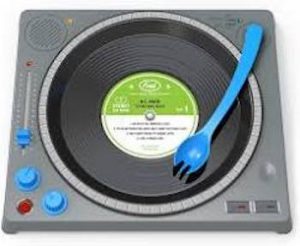
What Are You Doing for Dinner?
So… whatcha doin’ for dinner? What’s that? Did I make reservations? No, I’m not asking you out, I’m asking what you as a DJ are doing if and when your audience is eating dinner. You’d better say “I’m DJ’ing!”
Unfortunately, as I’ve recently learned, the answer from most DJs tends to be “I’m running a pre-made playlist.” When called out on the laziness of that statement, more than one have replied, “but I have it on shuffle, so it’s never the same set twice!” Shame on you!
It could be because I started DJ’ing when vinyl was the only option– unless you were one of those cassette tape DJs, you beast you– and it didn’t matter if the guests were having cocktails, dining, or dancing, I had to be at the turntables mixing from one record to the next, but I treat cocktail hour and dinner time the same way I do the dance portion of the affair. I’m reading the room, watching how people react to the song playing, and basing my choice of the next song off of what I see. If you take your craft seriously, you should be, too.
I know it’s tempting to fire up Spotify and press play, then sneak off to relax, or eat, or have a drink, or read a book, or scroll through TikTok, or do whatever else it is you do while your guests are eating, but resist that temptation. In the first place, it looks better if you are actively mixing music the entire time. You’re being paid for that time, right? Earn your paycheck. More importantly, while the guests are having cocktails, and later while they are eating, you have a chance to get them primed for dancing. Choose songs that get them bopping their heads and tapping their feet, and maybe even singing along, and build on those songs. Read your room, just as you do during your dance sets. If something doesn’t work, move on to something different. When something does work, build on it. Not only are you gathering important information for later, and better preparing yourself to get those guests dancing, you’re also subtly putting the guests into a good mood, which will make them much more likely to want to dance later.
If you are currently relying on playlists to get through the early stages of an event, I encourage you to abandon that practice immediately. If you aren’t, share below in the comments and let us all know what your strategy is for DJ’ing the non-dancing portions of events.

Early Opinions on Serato Stems
So we’ve all been using Serato’s new stems feature for a couple weeks. What opinions do we have? Let’s find out! But first, what are stems? In a nutshell, stems is a new feature in Serato that allows the DJ to isolate different parts of a song. When done well, it’s almost like having the master multi-track recording, and you can isolate just the drums, or only the vocals. This means you can, in theory, turn any song into an instrumental, or conjure up the acapella of any track. For some DJs this is an unnecessary extravagance, but for others it’s a game-changer.
Here are the thoughts of a few members of the Heavy Hits team:
Serg Sniper:
This Serato stems feature is going to allow me to mix blends on the fly when I’m live and test mash up ideas without opening my DAW.
DJ Precise:
I’m that DJ that never updates anything on their DJ laptop. From the operating system to the software, if it ain’t broke, don’t fix it (or update it). Therefore, I have yet to try the Serato Stems, but I will say it looks dope! Almost too good to be true. If it truly works properly this adds a whole new level to the creative aspect of your sets, especially live and on the fly. This may be the most game changing update in years. I’ll likely update to latest stems update soon but in the meantime I’ve enjoyed watching all the content online!
DJ Papi Cruz:
I love Virtual DJ stems, being able to create Acap or Intrusmentals on the fly is a game changer for DJ. I have been able to be more creative and spontaneous with my mixing of different genre and BPMs.
So there you have it– the initial opinions on Serato Stems. I’d love to know what you think about the feature, whether it be your opinion after having tried it or just your thoughts about the possibilities it offers. Comment away!
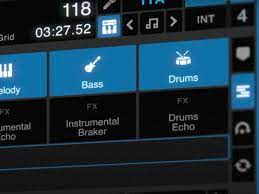
September 2022 Video Recap
Heavy Hits is more than a record pool. You obviously know about our blog– you’re reading it right now– but do you know about our YouTube channel? It’s full of information and tutorials designed to help you become a better DJ or producer. Here’s a recap of what was shared on our YouTube channel this month.
Here’s a how-to for mixing and DJ’ing with hip hop music.
Next, DJ And One shares a free site that all DJs should be using.
And finally, here’s how you can automate your light shows using Ableton

This One Simple Tip Will Make You a Better Record Scratcher!
Okay, maybe that title is hyperbole, and meant to parody clickbait, but the other day I was with a DJ who has been practicing turntablism for the past 6 years, and I noticed a flaw in his technique. I made a simple suggestion to him, and after making the adjustment told me that he was suddenly able to do some things with the record that he couldn’t do before. I was legitimately shocked by what he said, as I didn’t expect him to have any immediate results, and wasn’t even sure how much help my tip was going to be over the long haul.
Will this advice help you scratch better? I can’t say. But it might, so continue reading this briefest of blogs and give it a try. If you’re already doing what I am about to suggest, then so be it, but if not, and it helps, let me know. I’m genuinely curious if my friend is an outlier, or if this is something more burgeoning scratch DJs will be helped by learning.
The simple tip? Don’t move your arm when you scratch, and for the most part, don’t move your wrist, either. Nearly all your motion, and all the movement of the record should come from your fingers. That’s fingers plural, as my friend was only making contact with the vinyl with his middle finger. The middle finger does the bulk of the work, but your index and ring fingers should also be firmly on the record. Only your thumb and pinky are free. You’ll have far more control over the record that way, and by using only your fingers you will be able to accomplish much more precise maneuvers. You will use your wrist only when you want to apply greater force or speed, but that will be a quick movement, not a consistent series of movements. Your arm will move in reaction to your fingers, but none of the force you apply to the record should come from your arm.
Give it a try. Did it work? Yes? No? Maybe? Tell me!
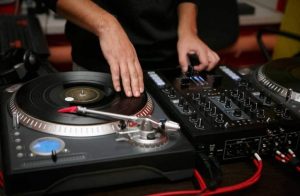
Meet DJ Dopez
No matter how skilled he may be, a DJ is nothing without a clever name, and near the top of the list of cleverly named DJs one must rank David Lopez, aka DJ Dopez. Don’t we all wish we had a name with such a built-in branding opportunity, and the awareness to utilize it?
Of course, DJ Dopez has dope skills to back up the name. He’s demonstrated those skills in numerous battles. Dopez was the Austin Regional DMC champ in 2015, and again in 2019, when he finished 4th at the U.S. Finals. In Austin, he’s part of a thriving turntablist scene, and is a regular at the city’s monthly scratch meetup, hosted by Scratch Theory of Texas.
He started scratching about 12 years ago, when he was 16. He’d been focused on mixing house music until he was exposed to turntablism, at which point he knew it was time to switch his focus to scratching.
His advice for becoming a great scratch DJ? Practice, of course, however he added a clever twist to that age-old advice. He used to spend 3+ hours a day playing video games, but channeled all that time into practicing scratching instead. He turned video game time into turntable time, which, when he was first learning, meant he spent 3 to 5 hours each and every day practicing on his turntables. He doesn’t spend that much time doing it now, and sometimes skips a day, but most days he still spends at least an hour behind the decks.
He mentioned DJ ie.Merge’s 2004 DMC set, which earned him the world title that year, as one aspiring DJs should watch. According to Dopez, ie.Merge introduced an aggressive cutting style over electronic beats that he admires. He named DJ Craze as his all-time favorite turntablist, and also mentioned DJ Chris Karns as one of the all-time greats.
Despite digging the aggressiveness of ie.Merge, Dopez listed a couple slower beats on the 2004 Toad Style battle record Get ‘Em as favorites. The beats clock in at around 92 BPM, but sound slower because of the beat layout, and are perfect for the sort of quick, intricate cuts Dopez specializes in. He also recommends checking out Toad Style’s mixtape, Switch Blade Sermons, for a clinic on cutting over a slow beat.
When it comes to choosing battle records, he’s especially partial to D-Styles, who he says has a really good ear for samples. Gag Ball Breaks and Black Market Snuff Breaks, both from The Wax Fondler, rate high on his list of great battle records, as does DJ Flare’s Hee-Haw Breaks, primarily for the sheer amount of samples it offers. Other favorites include Ricci Rucker’s Utility Phonograph Record and DJ Hertz’ Grasshopper Breaks, volume 1.
And for DJs looking for the best incarnation of the classic “aaaah” sample from Fab Five Freddy, Dopez swears by the version on Super Seal records. The warmth of the sample on those Dirt Style records is superior to the sound of the same sample on more recent battle records, which give the sample an unwanted metallic tone.
Here’s a quick video of him cutting up that aaaah:
Besides DJ’ing, Dopez is a fan of vintage clothing, especially t-shirts. He used to work at a thrift shop, and now scours local thrift shops, looking for t-shirts to sell in his eBay shop. If you want to check out his wares, you can find it here.
And what about when he isn’t DJ’ing or thrifting? He’s at home, spending time with his cat, Basil.
If you’re in the Austin area, you can hear Dopez spin every Thursday night at Barbarella, where he’s mixing music for the club’s patrons. If you want to hear him doing a more scratch-focused set, you can find him one Saturday a month at Lo-Fi Vintage, where you can also buy some sweet vintage tees.
Here’s another taste of his cutting to enjoy before you go.
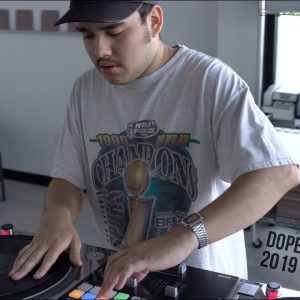
August 2022 Video Recap
Heavy Hits is more than a record pool. You obviously know about our blog– you’re reading it right now– but do you know about our YouTube channel? It’s full of information and tutorials designed to help you become a better DJ or producer. Here’s a recap of what was shared on our YouTube channel this month.
Everyone right now wants to know how to make a Jersey Club beat. Here’s how!
Next, DJ And One shares a free app that gives you constant access to your music library.
Here’s a lesson for mixing pop music.
And here is another lesson, this time teaching how to remaster old songs.

That Battle of the Bands… and the DJs
Did you know there was once a time when tensions were so high between DJs and musicians that the Musicians’ Union went as far as suing DJs, and sometimes picketed discotheques?
In the ’60s, DJ Jimmy Savile was being harassed by the local union, and came up with a novel solution. He hired a five-piece band, paid them in full, but told them not to show up. He knew he’d make far more by DJ’ing his party than he would if he enlisted a band, so his solution satisfied both the Musicians’ Union and his pocketbook.
It’s now the norm for a night club to make a DJ their featured entertainer. There are some that feature bands, but by far the majority of bars, clubs, and pubs rely on a DJ to provide their evening’s music. This wasn’t always the case. Until the 1960s, if you went to a club, you heard a live band. The idea of a guy playing records for the patrons to dance to didn’t yet exist. Once the concept of a DJ in a nightclub environment came into being, it had a brief run, but never threatened the dominance of bands as live entertainment. After a few years, the whole “DJ fad” seemed to fizzle out, but it came roaring back in the ’70s, and has never died down.
Even into the ’80s, it was the norm that a wedding DJ first had to convince a potential client that she wanted a DJ at her wedding, and not a band, before beginning to convince her that he was the right DJ for the job. Now, it’s a given that a DJ can provide suitable entertainment for a wedding, but it was a long road to get here.
I wonder what lies around the corner, waiting to replace DJs as the de facto entertainers in clubs and at weddings. Is it an algorithm? Or perhaps something else that doesn’t even exist yet. Never forget, no matter how entrenched you are in your industry, that can change overnight. Just as the car made the horse and buggy obsolete, something may be poised to send all of us DJs to the bread lines. Be ready!

Don’t Be Afraid! Be an Actor Instead!
Stage fright– it’s the worst, right? You’re fine when you’re home alone, DJ’ing in your bedroom, but even the thought of standing in front of a crowd petrifies you. And when you actually get behind the decks, it’s 100 times worse. But what can you do?
I can’t promise to cure you of your social anxiety, but let me share some things that have worked for me, and helped DJs I’ve mentored.
For starters, and perhaps most importantly of all, realize that no one at the show wants to see you fail. People go out to have fun. Have you ever heard anyone say “hey, let’s go out and see if we can have a terrible night at a place with a bad DJ?” That’s been said no times ever. The people in the room with you want you to succeed, and they are rooting for you. No one is staring at you hoping you will suck.
Sure, you say, that’s all fine and well, but just because they want me to succeed doesn’t mean I’m any less afraid to fail. That’s true. The next thing to realize is that you are more likely to make mistakes if you are worried about making them. Nervousness leads to errors. So your next trick is to learn not to be nervous. I’ll tell you how I did it, and maybe you can do it, too.
When I played my first paid DJ gig I was all of 14 years old. A babe in the woods. A mere scrap of a man. A waif, if you will. I was, like most 14-year-olds, shy and self-conscious, and scared to speak in front of a crowd. I had agreed to DJ the party without thinking through what was involved, and when I realized I’d have to stand in front of a room full of people, and sometimes talk to them on a microphone, I was suddenly regretting my promise to play. At the same time, I wanted to do it– and I wanted the $50 I was promised– so I pondered my options. An idea came to me.
I’d been in a couple school plays in grade school, and though I was a little nervous beforehand, I wasn’t too worried because I was playing a role. Everything I had to say was planned out ahead of time, and I’d memorized all the lines. It was not so much me up there as it was the character I was playing, and somehow that made a difference. I decided to try to capture some of that concept and repurpose it for DJ’ing.
I decided that once the party started, I was not going to be a shy, unpopular, 14-year-old freshman who preferred reading books to going to parties. Instead I was going to play a role. I was playing the part of an outgoing, fun, gregarious party-goer. I was playing the role of someone confident who loved talking on a microphone, and was at his best in a crowd. And you know what? It worked. And after awhile, I didn’t have to play a role when I DJ’ed, as I naturally became a more confident and outgoing person.
This may seem impossible to you now, as you sit and read this, but trust me and try it. The next time you have to DJ in front of an audience, tell yourself ahead of time that you aren’t you that night, you are you acting like a different you. You will thank you (and me) for it later.
Good luck! Let us know in the comments if this worked for you!

Last Night a DJ Saved My Life
In 1999, when I first read Last Night a DJ Saved My Life, Bill Brewster and Frank Broughton’s history of DJ’ing, I was, like many readers, enthralled by the club charts provided in the back of the book. They provided 11 song lists, each representative of a certain club or scene. My only complaint at the time was that none of them were centered around hip hop. There were plenty of house and disco lists, and one that included the most famous Northern Soul tracks, but not one offered any insight into what was going on in the world of hip hop.
Last week, I received my copy of the 2022 update of the book. They’ve made many changes, including rewriting some sections and adding some brand new chapters. It’s longer, and even more thorough, than before. They also expanded the song charts in the appendix, adding 10 more, for a total of 21 carefully curated lists. I was quite certain I’d see at least one hip hop list, but to my surprise: still none. Other than this somewhat significant, I believe, oversight, the book is fabulous. It’s informative, but more importantly, it’s inspiring. Whether you’ve never heard of DJ’ing, or if you are a seasoned pro with 40 or more years behind the decks under your belt, you will walk away from this book with a renewed passion for DJ’ing. You may also leave with a wistful feeling, wishing you could go back and experience some of the moments described, and wonder if the future of DJ’ing is as bright as its past. Regardless of what you feel, I guarantee you will feel something.
That said, I’m more than a little disappointed in their lack of some hip hop charts, so I spent the past couple days pulling out records and compiling a couple lists of my own. Here is the first one that I’ve completed. Consider this a chart representative of the hip hop scene before it was known as the hip hop scene. These are the records DJs were spinning double copies of, back and forth, to create looped beats for MCs and breakdancers. These are the pre-1980 breaks that form the foundation of what became known in the ’80s as hip hop. This is…
The ’70s Hip Hop Park Jam 100
20th Century Steel Band – Heaven and Hell is on Earth
7th Wonder – Daisy Lady
Aerosmith – Walk This Way
All the People – Cramp Your Style
B.W. Souls – Marvins Groove
Babe Ruth – The Mexican
Baby Huey – Listen to Me
Banbarra – Shack Up
The Bar-Kays – Let’s Have Some Fun
The Blackbyrds – Unfinished Business
Bo Diddley – Hit or Miss
Bob James – Take Me to the Mardi Gras
Boobie Knight & The Universal Lady – The Lovomaniacs (Sex)
Brooklyn Dreams – Music, Harmony and Rhythm
The Brothers Johnson – Ain’t We Funkin’ Now
Can – Vitamin C
Chester Randle’s Soul Sender’s – Soul Brother’s Testify
Chic – Good Times
Chicago Gangsters – Gangster Boogie
The Chubukos – House of Rising Funk
Coke Escovedo – I Wouldn’t Change a Thing
Commodores – The Assembly Line
Cymande – Bra
D.C. LaRue – Indiscreet
Dennis Coffey and the Detroit Guitar Band – Scorpio
Dexter Wansel – Theme from the Planets
Donald Byrd – Change (Makes You Want to Hustle)
Dyke & the Blazers – Let a Woman be a Woman and a Man Be a Man
Dynamic Corvettes – Funky Music is the Thing
Eastside Connection – Frisco Disco
Esther Williams – Last Night Changed it All (I Really Had a Ball)
Fat Larry’s Band – Down on the Avenue
Fausto Papetti – Love’s Theme
First Choice – Love Thang
Foster Sylvers – Misdemeanor
Freddie Perren – 2 Pigs and a Hog
Freedom – Get Up and Dance
Funk Inc. – Kool is Back
Gaz – Sing Sing
The Grass Roots – You and Love Are the Same
The Headhunters – God Make Me Funky
Herman Kelly and Life – Dance to the Drummer’s Beat
The Honey Drippers – Impeach the President
In Search Of… Orchestra – Phenomena Theme
Incredible Bongo Band – Apache
Incredible Bongo Band – Bongo Rock
Isaac Hayes – Breakthrough
Jackie Robinson – Pussyfooter
The Jackson Five – It’s Great to be Here
James Brown – Give it Up or Turnit a Loose
James Brown – The Funky Drummer
James Brown – Funky President
Jimmy “Bo” Horne – Get Happy
The Jimmy Castor Bunch – It’s Just Begun
Joe Tex – Papa Was, Too
John Davis and the Monster Orchestra – I Can’t Stop
Johnny “Hammond” Smith – Shifting Gears
Johnny Jenkins – I Walk on Gilded Splinters
Johnny Pate – Shaft in Africa (Addis)
Juice – Catch a Groove
The Kay-Gees – I Believe in Music
Kid Dynamite – Uphill Peace of Mind
Kool & the Gang – N.T.
Lafayette Afro-Rock Band – Hihache
Lamont Dozier – Take Off Your Make-Up
Lee Dorsey – Get Out of My Life, Woman
Lowell Fulsom – Tramp
The Magic Disco Machine – Scratchin’
Mahavishnu Orchestra / John Mclaughlin – Planetary Citizen
Manzel – Space Funk
Marvin Gaye – “T” Plays it Cool
Melvin Bliss – Synthetic Substitution
The Meters – Handclapping Song
Miami – Chicken Yellow
The Mohawks – The Champ
Monk Higgins – One Man Band (Plays All Alone)
Mountain – Long Red
The Olympic Runners – Put the Music Where Your Mouth Is
Orchestra Internationale – Chella Lla’
Please – Sing a Simple Song
Pleasure – Joyous
La Pregunta – Shangri La
Ralph McDonald – Jam on the Groove
Rhythm Heritage – Theme from S.W.A.T.
Rick James – Fire It Up
Roy Ayers Ubiquity – Running Away
Rufus Thomas – Do the Funky Penguin
Sir Joe Quarterman and Free Soul – I’m Gonna Get You
The Soul Searchers – Ashley’s Roachclip
Stanley Turrentine with Milt Jackson – Sister Sanctified
Thin Lizzy – Johnny the Fox Meets Jimmy the Weed
The Village Callers – Hector
The Whole Darn Family – Seven Minutes of Funk
Wilbur Bascomb and the Zodiac – Just a Groove in “G”
The Wild Magnolias – (Somebody Got) Soul, Soul, Soul
Wilson Pickett – Get Me Back on Time
The Winstons – Amen Brother
Yellow Sunshine – Yellow Sunshine
Z.Z. Hill – I Think I’d Do It
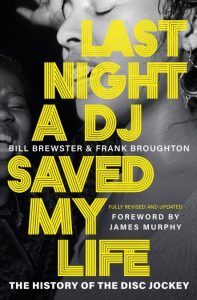
July 2022 Video Recap
Heavy Hits is more than a record pool. You obviously know about our blog– you’re reading it right now– but do you know about our YouTube channel? It’s full of information and tutorials designed to help you become a better DJ or producer. Here’s a recap of what was shared on our YouTube channel this month.
To celebrate Independence Day in the United States of America, our resident YouTube creator DJ And One shared a special 4th of July mix.
Next, DJ And One teaches how to mix house music.
DJ Poison Ivy gives a reminder about the Burna Boy remix contest.
Next, a lesson about setting cue points in Serato.
And finally, part 2 of the series of mash-up lessons.

